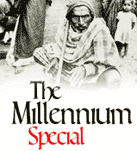The rediff columnist's ten predictions for the next 100 years
To paraphrase Oscar Wilde, I can predict anything but the future! Nevertheless, as someone who has consistently believed that India's future is certainly brighter than her disgraceful present, I shall take a stab at what I think the next one hundred years have in store. In passing, let us note that, despite the obvious shortfalls, we have come a long way, indeed -- it would have taken a very brave prognosticator indeed in 1899 to predict anything other than slavery for India in 1999.
India's ills are primarily self-imposed -- derived from poor strategic thinking, lack of self-confidence, and a tendency towards fratricide. Alas, these trends continue apace today. Fortunately, there are several worldwide trends -- towards heterogeneity, towards globalization, towards abstraction -- which should help India.
India has managed a remarkably diverse set of people for millennia -- racially, culturally, linguistically, and in every other way we have vast differences -- and this is something the globally capable industry of tomorrow needs: the ability to work with differences. Homogeneous cultures that do not allow for pluralism -- for instance the Semitic-religion-dominated West or Han-dominated China -- are ill-equipped to deal with an increasingly heterogeneous marketplace. With its tolerant Indic heritage that accepts (and even revels in) differences -- e pluribus unum as the Americans say, or bhinnaka tungalika as per the Indonesians -- India is well equipped culturally for the new Pacific century.
Similarly, India's strength all along has been in abstract thought, in ideas. Perhaps it is true, as Gurcharan Das, management guru, suggests, that India lost out on the Industrial Revolution because we do not have a culture of tinkering; he believes, however, that as the currency of the future becomes ideas, India has a competitive advantage. Of course, India has produced some of the greatest ideas in history -- the zero, Buddhism, and non-violence.
Sociologist Joel Kotkin once suggested that the 'oil' of the next century is engineering. Just as the possession of petroleum enabled West Asia, hitherto a wasteland, to prosper, the skills in engineering, and more generally, in intellectual property, that India appears to have, should be a major competitive advantage.
 At the root of India's problems is economics. A remarkably productive and entrepreneurial populace -- one that, a mere four hundred years ago, owned 25 per cent of the world's manufacture of goods -- has become a basket-case, accounting today for only 0.5 per cent of world trade. This hollowing out of the Indian economy primarily thanks to the British, but also thanks to the hubris of India's central planners, is to be blamed for the continuing suffering of 1 billion people. This can and will be turned around.
At the root of India's problems is economics. A remarkably productive and entrepreneurial populace -- one that, a mere four hundred years ago, owned 25 per cent of the world's manufacture of goods -- has become a basket-case, accounting today for only 0.5 per cent of world trade. This hollowing out of the Indian economy primarily thanks to the British, but also thanks to the hubris of India's central planners, is to be blamed for the continuing suffering of 1 billion people. This can and will be turned around.
And from economic strength will flow another major benefit -- that of self-confidence. As the East Asians have demonstrated, with money comes respect, and self-respect, and a desire to preserve and utilize the positives in its own culture. A resurgent India that is gaining prosperity will also automatically make the current fissiparous tendencies go away -- the northeast and Kashmir will recognize that they are better off within India than without.
Yes, there is hope, and that is what I base my optimistic perspectives on.
1. In certain sunrise service industries, India becomes a world leader by 2050, one of the top three producers of:
· Intellectual property, especially in information technology, but also in areas like pharmaceuticals.
· High-value-added services, such as medical services, entertainment-related services.
· Low-value-added services, such as in IT-enabled services like call centers, medical transcription.
· Advertising, video, media and related services.
2. In certain manufacturing areas, India is already or becomes a world leader by 2020, as one of the two three producers of:
· Agricultural products, including processed fruits and vegetables, milk products, marine products.
· Leather goods.
· Gemstones and jewelry
3. The Indian economy reaches take-off stage as soon as 2005, with a consistent and real growth rate of 8 to 9 per cent in GDP per year. In twenty years, this will mean that per-capita incomes quadruple from about $ 300 to about $ 1,200 in current dollars. Abject poverty will disappear except in pockets.
4. As a direct corollary of number 3, secessionist movements in various parts of India cease to be attractive to the public. Similarly, caste-based agitations and animosities grow less important, as there is a larger pie for people to share.
5. Again as a corollary of number 3, the net population growth rate falls much faster than anticipated, and India reaches a stable, self-sustaining population of 1.2 billion by 2020. Even in the Gangetic plains states, Zero Population Growth becomes a reality. There is a side-benefit: India has a much larger percentage of productive people in their youth as compared to the ageing populations of the OECD nations. Furthermore, epidemics, including AIDS, cease to ravage the countryside because of improved prevention and primary health care.
6. Indian culture and literature gain rightful acceptance as one of the world's greatest traditions. At least three Indians will win the Nobel Prize in Literature by 2050. The number of universities offering programs in Indic studies goes up by a factor of ten. Sanskrit, Pali and Tamil on the classical side, and modern Indian languages on the other side, are taken up with interest by both Indians and foreigners.
 7. With great national pride, India hosts the Olympics before 2050. Japan, Korea and others announced their arrival on the world scene by successfully holding the Olympics in their nations; similarly India will, too.
7. With great national pride, India hosts the Olympics before 2050. Japan, Korea and others announced their arrival on the world scene by successfully holding the Olympics in their nations; similarly India will, too.
8. Indian cuisine becomes recognized as one of the world's greatest and most popular. Just as 'curry' has become Britain's national dish, and Thai restaurants have stormed the US, Indian restaurants -- including those offering the varied and innovative regional cuisines (eg. Hyderabadi, Malabar, Chettinad, Lucknowi, Kashmiri, Bengali) -- become fixtures worldwide.
9. The regional groupings -- SAARC, the Indian Ocean Rim group, the India-Bangladesh-Thailand-Burma group, etc. -- become major trading organizations, and also become strategic partners in military alliances aimed at keeping at bay the Chinese, the Americans and others with ambitions. India also acquires blue-water strike capabilities as well as ICBMs by 2040.
10. The transportation and telecom infrastructure in India improves beyond recognition, as new highways and airports are built and telecom is thrown fully open to competition. By 2050, there are 10,000 new miles of limited-access toll-roads, 20 containerized and computerized ports, and the major airports have been upgraded to international class facilities. In a fit of wild optimism, I also predict that the Indian predilection for driving like maniacs diminishes, so that Indian roads are no longer exciting demolition derbies!
Illustrations: Dominic Xavier
Rajeev Srinivasan is a computer industry entrepreneur and a columnist for rediff.com
Tell us what do you think of this list?
